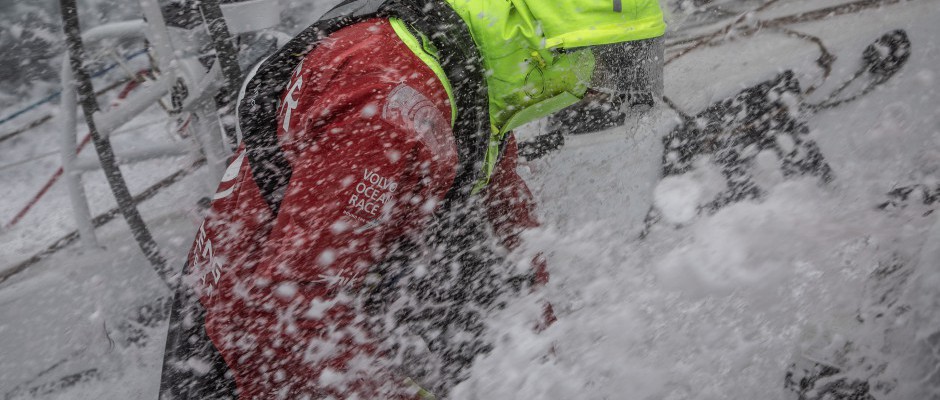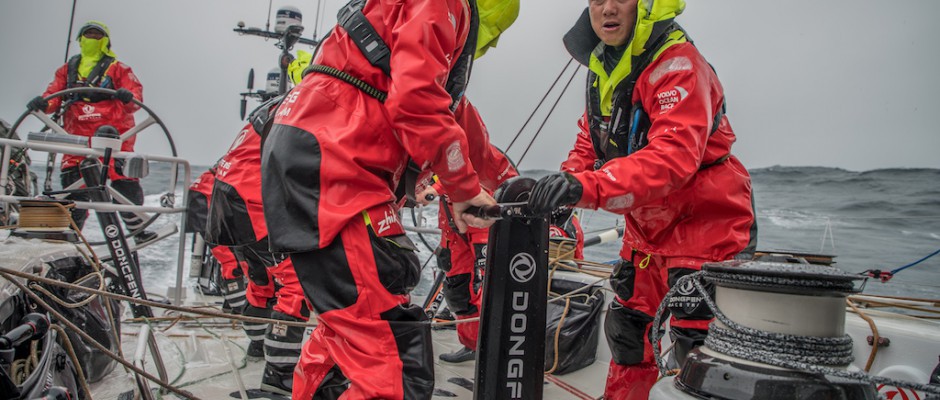Well, it has been exactly seven days since the starting gun fired off Itajai signifying the start of leg 8 to Newport and my own return to the DFRT after last jumping off the boat in Melbourne. It seems like a long time ago and I have followed closely the exploits, the ups and downs of the team since then. All was well of course as we lead the overall standings - if only narrowly!
I have to admit the first day or so back on board I really had to think hard about everything I did to make sure I was not making any silly mistakes after being away for so long. But quickly I slipped back into the regular routine and after a few days I could relax a bit more and enjoy the sailing.
Except there was not much chance for any relaxing. As usual the fleet was basically tethered together for the first few days - tacking on every shift in unison as we beat upwind advancing towards Cabo Frio. A couple of exceptionally tricky nights made regular sleep an impossibility as we battled huge rain clouds, squalls and wildly variable wind directions.
It’s hard to believe, but at one stage a squall (at night in the pitch black of course) moved on us so quickly, with such a rapid change of wind direction, that we barely had time to tack the boat and keep on our course before we were heading back to Itajai. Thankfully we made it but had zero chance to move any stack (think ALL the sails, food, equipment and spares we carry on board) let only drain the water ballast. So there we were sailing upwind on port tack somewhat northwards (which was a relief at least) while all the gear and water ballast was set up for sailing on the other tack. What to do now? Fight gravity and move everything to windward? Or tough it out and wait for the next shift back which HOPEFULLY would come soon. We chose the latter option and about 20 or 30 minutes later we were able to tack back onto starboard once that particular rain squall was done with us.
Many more rain clouds followed over the subsequent days and it was a game of finesse to thread your way through trying to avoid a disaster - a little bit of good luck always goes a long way too.
These conditions are always tough on the crew both physically and mentally, I would say even toughest for Charles and Pascal. They have to make decisions that strike the right balance between taking every possible windshift or other opportunity and avoid physically (and/or mentally?) breaking the crew. It is very easy to say ‘right - let’s change sails or let’s tack now or gybe now and take a quick gain,’ but this has to be balanced against giving the crew some rest and also the often harder decision - will the sail change, tack or gybe actually be worth it?
So many times during these races we wait for the regulation “cup of tea” time to pass before committing to a decision to change sails - only for the wind to almost immediately change again requiring a change back to the same sail. This can be frustrating and even infuriating for all of us and especially when it happens multiple times in a short space of time. It is at times like these that we have to remember we are all in this together and no one is purposefully trying to make us do unnecessary changes. We are all good sailors and no one ever gets it right all the time.
We are lucky to have a great mix of experience to have good discussions about these calls. Stress levels rise even more as fatigue becomes a factor and for sure three days into this leg EVERYONE was suffering from a lack of sleep. Fortunately the breeze then settled and we could ease gradually back into a more regular watch system.
I am going to sign off now as I need to catch up on some sleep again after another very busy day with lots of gybing as we passed the corner of Brazil and started the sprint to Newport. I say sprint although the finish is still around 8 or 9 days away because we treat every four-hour watch as a mini-race within a race and put everything into extracting the best possible speed for each session on deck.
That said we have to make time for some light relief and yesterday Jeremie produced a Rubik’s Cube circa 1980 with a request for someone to solve it for his OBR story. No volunteers appeared although I did manage to complete two layers after dredging up some long lost moves from my time as a 10 year old cubist - is that even a word? If anyone can please send me instructions on how to complete the last layer I might even be able to get it done in the slowest time this year before we reach Newport.
Until Newport,
Kind Regards,
Stu Bannatyne














